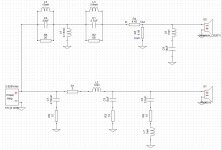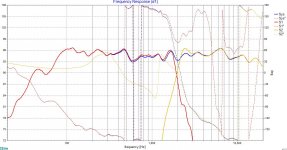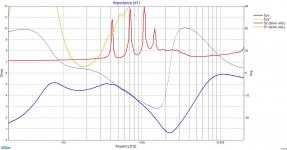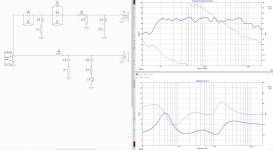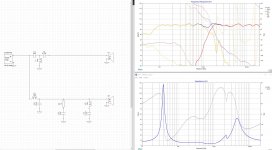Hi All
I'm trying to build 2-way speakers for my small band.
Since I'm new to this world, I wanted your professional review on my crossover design before I buy the parts and build it.
Not sure which details I should provide you, But I hope that the pictures attached will say everything.
I'm trying to build 2-way speakers for my small band.
Since I'm new to this world, I wanted your professional review on my crossover design before I buy the parts and build it.
Not sure which details I should provide you, But I hope that the pictures attached will say everything.
Attachments
There's alot of stuff needing to be addressed with your crossover.
What's the reasoning behind R9, C7 and R1? Having a 3 ohm resistor in line with the woofer doesn't make any sense. How did you come up with that crossover design? That massive 1 ohm impedance dip is going to cause amplifier problems. That's likely caused by the L4 in the HP, which shouldn't be that small crossing over at 2k.
The selenium D220 doesn't need much response shaping in the midband, unless you use it on a weird type of waveguide. The woofer doesnt really need much filtering since it already falls off sharply at 2k, maybe just needs a zobel and a larger inductor for BSC.
What's the reasoning behind R9, C7 and R1? Having a 3 ohm resistor in line with the woofer doesn't make any sense. How did you come up with that crossover design? That massive 1 ohm impedance dip is going to cause amplifier problems. That's likely caused by the L4 in the HP, which shouldn't be that small crossing over at 2k.
The selenium D220 doesn't need much response shaping in the midband, unless you use it on a weird type of waveguide. The woofer doesnt really need much filtering since it already falls off sharply at 2k, maybe just needs a zobel and a larger inductor for BSC.
profiguy obviously knows the drivers, but for those who don't...
Dayton Audio PN395-8 - 15" Woofer
D220 Ti | JBL Professional Loudspeakers
Dayton Audio PN395-8 - 15" Woofer
D220 Ti | JBL Professional Loudspeakers
This guys has done all of the hard work for you, $20 sounds like a reasonable price to pay.
The Soundstage 15 - 15" 2-way HiFi Speaker Plans - Toid's DIY Audio
Videos on YouTube as well.
The Soundstage 15 - 15" 2-way HiFi Speaker Plans - Toid's DIY Audio
Videos on YouTube as well.
I would love to see someone build those. I have no place to put a set, but they look like they'd be fun.
This guys has done all of the hard work for you, $20 sounds like a reasonable price to pay.
The Soundstage 15 - 15" 2-way HiFi Speaker Plans - Toid's DIY Audio
Videos on YouTube as well.
I'm familiar with this work but definitely want to build things with my own hands. I used the same drivers since I think this will fit my app.
"small band" ?
//
Yes, we are 3-4 people that like to play together in my house (small room).
We have electronic drums, a guitar and a piano (and sometimes a singer).
I guess the main app is playing music.
There's alot of stuff needing to be addressed with your crossover.
What's the reasoning behind R9, C7 and R1? Having a 3 ohm resistor in line with the woofer doesn't make any sense. How did you come up with that crossover design? That massive 1 ohm impedance dip is going to cause amplifier problems. That's likely caused by the L4 in the HP, which shouldn't be that small crossing over at 2k.
The selenium D220 doesn't need much response shaping in the midband, unless you use it on a weird type of waveguide. The woofer doesnt really need much filtering since it already falls off sharply at 2k, maybe just needs a zobel and a larger inductor for BSC.
Thanks for your detailed reply.
Please let me try to explain (to the best of my knowledge...)
R9 and C9 - reduced the very high jump on the Imp. together with them, I got "flat" Imp not higher than 8 Ohm. Isn't that what's needed? I really don't know...
R1 - reduced the F3 to be flat. without this resistor I got higher response at the lower freq.
1 Ohm Imp dip - Correct. it is caused by L4. Should I add series resistor to that?
I'll appreciate it if someone could draw the parts needed to get a good cross-over design and Ill do the tuning.
Don't worry, you have got plenty of work left for your hands if you go with his plans. If this is what you want and even the components of your choice, what can you win? You can still invest the enourmous amount of time to learn crossover electronics, but there will be something in your hand from the beginning. You can build the thing and know it is going to happen. You could get yourself a measuring microphone on top and some additional components, just for fun and change the proven crossover design and learn from experience the difference in sound; and then you can finish the speaker according to plan, still within some months. This is so great!I'm familiar with this work but definitely want to build things with my own hands. I used the same drivers since I think this will fit my app.
Interesting project. I have some spare 15” and a d220 myself is it possible to cross as low as 1kHz? I guess a 18dB filter would be needed then. Will follow this thread for sure. That build looked like fun, no ******** just straight to the point.
For making LIVE music, IMO you are just spinning your wheels until you go Bi-Amp. It makes a HUGE difference:
BiAmp (Bi-Amplification - Not Quite Magic, But Close) - Part 1
BiAmp (Bi-Amplification - Not Quite Magic, But Close) - Part 1
I'm sorry for being somewhat rude, but if you would know how to tune a crossover, you would know how to design one. And from the first attachments, I doubt if you do so. Look at the impedance drop at 2k, your amp will like that 😉.I'll appreciate it if someone could draw the parts needed to get a good cross-over design and Ill do the tuning.
Really, do yourself a favor, build a known design with a know crossover. Or start from scratch, throw simulation apps away and go read about speaker and crossover design. Would you fly a plane without practice and qualifications?
I do appreciate every comment.
Just to explain, I'm an HW ee. eng. working for many years in the industry of high-speed designs. Unfortunately never dealt with audio. but, ... I do like to do things with my own hands and understand everything I do.
Hence, I took your advices above and come up with two new options which differ by their impedance response. [see attached files]
It would be great to get your comments.
I promise that once the cross-over will be finalized, I'll be more than happy to share my design with you.
Just to explain, I'm an HW ee. eng. working for many years in the industry of high-speed designs. Unfortunately never dealt with audio. but, ... I do like to do things with my own hands and understand everything I do.
Hence, I took your advices above and come up with two new options which differ by their impedance response. [see attached files]
It would be great to get your comments.
I promise that once the cross-over will be finalized, I'll be more than happy to share my design with you.
Attachments
- Home
- Loudspeakers
- Multi-Way
- 2-way loudspeakers for small band
